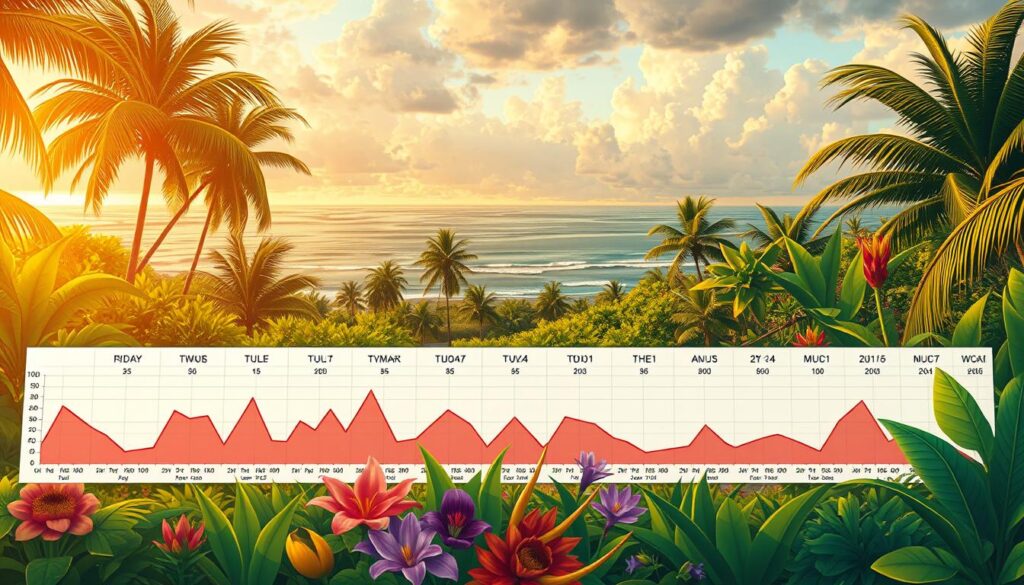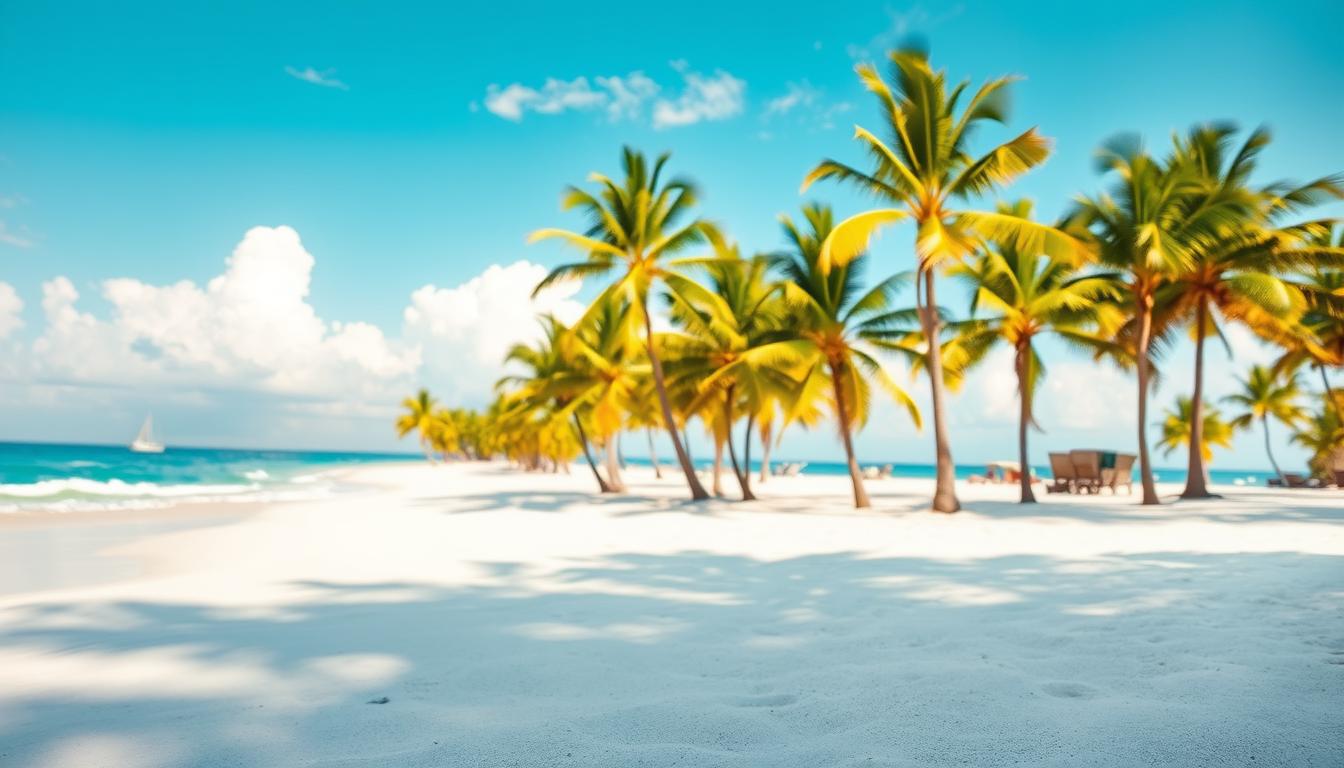Playa del Carmen, a vibrant coastal destination in Mexico, is renowned for its inviting climate that attracts visitors and residents alike. The region’s temperate weather creates a welcoming environment, making it a popular choice for travelers and those looking to relocate. Whether you’re planning a short visit or considering a longer stay, understanding the local climate is essential to making the most of your experience.
The daily high temperatures in Playa del Carmen typically range between 82°F and 90°F, with rare occurrences of temperatures exceeding 93°F. This consistent warmth, combined with mild winters and warm summers, ensures a pleasant atmosphere year-round. The climate’s stability is a key factor in the area’s appeal, offering a tropical vibe without extreme heat fluctuations.
This overview sets the stage for a deeper exploration of Playa del Carmen’s climate. In the following sections, we’ll delve into a month-by-month breakdown and seasonal trends, providing insights to help you plan your trip or relocation with confidence. Let’s embark on this climate journey and uncover what makes Playa del Carmen such a desirable destination.
Key Takeaways
- Playa del Carmen enjoys a tropical climate with consistent temperatures year-round.
- Daily high temperatures typically range between 82°F and 90°F.
- Extreme temperatures above 93°F are rare.
- The destination offers mild winters and warm summers.
- The stable climate makes it appealing for both tourists and residents.
Overview of Playa del Carmen’s Climate
Playa del Carmen’s climate is a perfect blend of tropical warmth and coastal comfort, making it a haven for both travelers and residents. Located on the Caribbean coast of Mexico, the region benefits from a unique geography that shapes its weather patterns.
Geographical Influences and General Weather
The proximity to the Caribbean Sea and the influence of trade winds significantly impact the local weather. The coastal breeze helps moderate temperatures, preventing extreme heat and creating a pleasant environment. The tropical climate is characterized by high humidity, particularly during the summer months, but the ocean currents help balance these conditions.
Key Climate Characteristics
The region experiences a distinct wet and dry season. Summers are typically hot and humid, with occasional overcast skies, while winters are mild and sunny. The humidity levels are highest during the summer, with an average of 80%, but the coastal breeze provides relief. Sunrise times remain relatively consistent throughout the year, ranging from 6:30 AM to 7:30 AM, while sunsets occur between 5:30 PM and 8:30 PM.
These climate characteristics make Playa del Carmen an attractive destination. The warm weather, manageable humidity, and clear winter skies create an ideal environment for outdoor activities and relaxation. Whether you’re planning a vacation or considering relocation, understanding the climate is key to making the most of your experience.
Playa del Carmen average temperature: Yearly Trends & Insights
Understanding the yearly temperature trends in this coastal destination is key to planning your visit or relocation. The region’s climate is characterized by consistent warmth, with daily highs typically ranging between 82°F and 90°F throughout the year.
The data reveals a clear pattern: warm days dominate the calendar, with occasional cooler evenings, especially during the winter months. This balance creates a comfortable environment for outdoor activities year-round.
Key Insights:
- The climate shows minimal variation, with temperatures rarely dropping below 70°F.
- Historical weather reports indicate a steady increase in daytime warmth during summer months.
- Nighttime temperatures remain mild, offering a refreshing contrast to the daytime heat.
Seasonal changes are subtle, with the most noticeable difference being the humidity levels during the summer. This consistent climate makes the region appealing for both tourists and residents, providing a tropical experience without extreme temperature fluctuations.
Seasonal Variations: Hot and Cool Periods
The climate in this coastal destination offers a distinct contrast between its hot and cool seasons, creating a unique experience for visitors and residents alike.
Hot Season Highlights
The hot season, which runs from April 20 to September 16, brings high temperatures averaging around 90°F. During the peak month of July, the average high temperature reaches 91°F. This period is characterized by increased humidity, which can make the air feel warmer than the actual temperature. Despite the heat, the coastal breeze provides some relief, making outdoor activities still enjoyable.
Cool Season Overview
In contrast, the cool season from November 28 to February 13 offers milder conditions, with average high temperatures around 77°F. This period is marked by lower humidity levels, creating a more comfortable environment. The cooler months are ideal for outdoor activities like exploring the region or enjoying water sports, making this time of year particularly popular among tourists.
These seasonal variations make the destination appealing year-round. Whether you prefer the warmth of summer or the mild winters, there’s always something to enjoy. The clear contrast between seasons ensures a diverse experience, catering to different preferences and activities.
Monthly Climate Breakdown and Weather Patterns
Exploring the monthly climate variations offers a detailed look at how the weather changes throughout the year. This breakdown helps visitors and residents plan activities and make informed decisions about the best times to enjoy the region.
Temperature Ranges by Month
Throughout the year, the region experiences consistent warmth with notable variations in temperature. For instance, January, often considered one of the cooler months, has an average high of 77°F and a low of 67°F. In contrast, July is the hottest month, with temperatures reaching a high of 90°F and a low of 78°F. These temperature ranges provide a clear picture of what to expect each month.
Rainfall and Precipitation Trends
Rainfall patterns also vary significantly from month to month. September stands out as the wettest month, with an average of 5.6 inches of rainfall, while March is the driest, receiving only 1.2 inches. Understanding these precipitation trends is crucial for planning outdoor activities and ensuring a enjoyable experience.

These monthly insights help travelers and residents alike make the most of their time. Whether you’re looking to avoid the rain or soak up the sun, knowing the climate patterns makes planning effortless. For those interested in real estate opportunities, understanding the climate can also highlight the best times to invest in high ROI properties in the area.
| Month | High Temp (°F) | Low Temp (°F) | Rainfall (in) |
|---|---|---|---|
| January | 77 | 67 | 2.4 |
| July | 90 | 78 | 3.1 |
| September | 89 | 77 | 5.6 |
| March | 78 | 66 | 1.2 |
This detailed breakdown ensures that every visitor and resident can plan their activities with confidence, making the most of the region’s inviting climate year-round.
Understanding Daily Highs and Lows
Every day in this coastal destination unfolds with a predictable pattern of warmth, creating a rhythm that residents and visitors alike can easily adapt to. The interplay of sun, sea, and breeze crafts a unique daily temperature cycle that is both inviting and manageable.
Typical Daily Temperature Shifts
The day begins with mild mornings, gradually warming as the sun climbs. By late morning, the warmth becomes more pronounced, setting the tone for a pleasant afternoon. As evening approaches, the heat gently subsides, leading to cooler nights.
This daily ebb and flow of temperatures is influenced by coastal breezes and the region’s geography. The consistent patterns make it easier to plan daily activities, whether it’s exploring the area or simply enjoying the outdoors.
| Time of Day | Temperature Range (°F) |
|---|---|
| Early Morning | 70-75 |
| Late Morning | 78-82 |
| Afternoon | 84-88 |
| Evening | 75-80 |
| Nighttime | 68-73 |
Understanding these daily shifts is key to making the most of your time here. For those considering a move, this predictable climate offers a comfortable environment year-round. If you’re planning a visit, check out our honest reviews of local resorts to find the perfect spot to enjoy the region’s inviting weather.
Cloud Cover and Its Impact on Weather
Cloud cover plays a significant role in shaping the daily weather experiences in this tropical paradise. While many associate sunny skies with ideal vacation weather, cloud cover brings its own set of benefits and effects on both climate and outdoor activities.
Clear vs. Overcast Conditions
Clear skies dominate during the dry season, creating perfect conditions for sunbathing and outdoor adventures. February stands out as the clearest month, with only 22% cloud cover, making it ideal for photography and enjoying the Caribbean views. In contrast, September experiences the highest cloudiness at 78%, bringing overcast conditions that can last for most of the day.
These variations in cloud cover significantly influence temperature perception. Clear skies allow more direct sunlight, warming the environment, while overcast conditions can make the atmosphere feel cooler and more humid. Understanding these patterns helps in planning activities, whether it’s a day at the beach or an evening stroll.
| Month | Cloud Cover (%) |
|---|---|
| February | 22 |
| September | 78 |
Cloud cover also impacts tourism, with clear skies attracting beachgoers and overcast days encouraging indoor activities. This natural balance ensures a diverse experience, catering to different preferences and making the destination appealing year-round.
Assessing Humidity and Dew Point Levels
Humidity plays a crucial role in how we perceive the climate, making it feel warmer than the actual temperature. Understanding humidity levels and dew points helps us better appreciate the comfort factors in this tropical destination.
Comfort Levels and Perceived Humidity
The region experiences a muggier period that lasts roughly 9 months, with humidity levels often exceeding 80%. During these months, the high humidity can make the air feel oppressive, especially during the summer. Dew point levels, which measure the moisture in the air, are key to understanding comfort. A dew point of 70°F or higher significantly increases the perceived humidity, making the environment feel warmer.
| Dew Point (°F) | Comfort Rating |
|---|---|
| 65 | Comfortable |
| 70 | Mildly Humid |
| 75 | Uncomfortably Humid |
| 80 | Very Oppressive |
Understanding these factors helps in planning activities and making informed decisions about the best times to visit or reside here. By considering both humidity and dew point, travelers can better prepare for their experiences in this beautiful coastal destination.
Wind Patterns and Their Effects on the Coast
Wind plays a vital role in shaping the coastal experience, influencing everything from weather conditions to outdoor activities. Understanding wind patterns helps residents and visitors make the most of their time here.
Average Wind Speed Insights
The average wind speed in this coastal destination is around 7 mph, creating a gentle breeze that enhances the overall comfort. However, there are notable variations throughout the year. For instance, March tends to be windier, with speeds reaching up to 9 mph, while September is generally calmer, averaging about 5 mph.
Direction and Seasonal Trends
Wind direction is predominantly from the east, which helps moderate the climate by bringing in cool ocean air. This easterly wind is most consistent during the summer months, providing relief from the heat. Seasonal trends show that wind speeds are higher during the spring and fall, which can improve cooling and air quality, especially on warmer days.
| Month | Wind Speed (mph) |
|---|---|
| March | 9 |
| July | 8 |
| September | 5 |
As a local resident once noted, “The breeze here is like a natural air conditioner, making even the hottest days feel refreshing.” This consistent wind pattern not only enhances the climate but also makes outdoor activities like beach visits and water sports more enjoyable. Whether you’re planning a day by the sea or exploring the town, understanding the wind trends can elevate your experience.

For those looking to make the most of their stay, consider exploring must-have resort amenities that offer wind-friendly facilities, ensuring a comfortable and pleasant experience.
Coastal Water Temperature Variations
Just as the air temperature in this stunning destination varies with the seasons, so does the temperature of the coastal waters. This harmony between land and sea creates a unique environment that enhances both the climate and the overall experience for visitors.
Warmer and Cooler Water Seasons
The warmer water season typically runs from July to October, with sea temperatures averaging above 83°F. These inviting conditions make it an ideal time for swimming, snorkeling, and other water activities. Conversely, the cooler water season, which occurs during the winter months, sees temperatures dipping to around 79°F, still pleasant for outdoor enjoyment.
| Season | Water Temperature Range (°F) |
|---|---|
| Summer | 83-86 |
| Winter | 79-82 |
This synergy between air and water temperatures plays a significant role in shaping the region’s appeal. The consistent warmth of both elements ensures a year-round inviting climate, making it a paradise for beach lovers and outdoor enthusiasts alike.
Sunlight, Daylight, and Solar Energy Analysis
Understanding the interplay of sunlight and daylight in this coastal destination is key to appreciating its climate. The region experiences a remarkable variation in daylight duration throughout the year, ranging from 10 hours and 53 minutes in December to a peak of 13 hours and 23 minutes in June.
Solar Radiation and Daily Energy
The solar radiation levels are highest during the summer months, reaching peak intensity at midday. This intense sunlight not only warms the environment but also enhances the potential for solar energy. For instance, midday solar radiation levels can make the air feel warmer than the actual temperature, creating a cozy atmosphere for outdoor activities.
Daylight Duration Trends
The variation in daylight hours significantly impacts daily life. Longer days in summer provide ample opportunities for outdoor adventures, while shorter winter days offer a serene environment for evening strolls. This balance makes the destination appealing year-round, with each season offering unique experiences.
The data from local weather stations highlights the importance of daylight trends in planning visits. Whether you’re an early riser or a night owl, understanding these patterns ensures you make the most of your time here. The consistent sunlight also supports renewable energy initiatives, making it an attractive location for eco-conscious investments.
Implications for Tourism and Outdoor Activities
The tropical climate of this stunning coastal destination creates a perfect setting for unforgettable vacations and outdoor adventures. With its inviting weather, it attracts travelers from around the globe, offering a blend of relaxation and excitement.
Tourism Score and Best Weather Windows
Tourism scores here peak during the dry season, which runs from early December to mid-March. This period offers ideal conditions for outdoor activities, with clear skies and comfortable temperatures. If you’re planning a visit, consider the best weather windows from mid-November to early May for optimal beach and pool experiences.
- The dry season offers perfect weather for swimming, snorkeling, and exploring.
- Mid-November to early May is the best time for water activities.
- Plan your visit during these periods for an unforgettable experience.
Beach/Pool Comfort Factors
The combination of warm waters and pleasant air temperatures makes this destination a paradise for beachgoers. The water temperature remains warm throughout the year, ranging from 79°F in winter to 83°F in summer. This consistency ensures that swimming and water sports are enjoyable year-round.
For those seeking relaxation, the mild winters and warm summers provide the perfect environment for poolside lounging. Whether you’re looking to unwind or stay active, the climate here caters to all preferences.
Understanding the local climate is key to planning your trip. By choosing the right time to visit, you can make the most of your experience here. Let the reliable climate data guide you in selecting the perfect travel period for your next adventure.
Growing Degree Days and the Growing Season
Growing degree days, or GDD, are a way to measure the amount of heat available for plant growth. This concept helps us understand how much warmth plants receive over time. In this region, GDD are used to predict how plants will grow during the year. Even though the area stays warm all year, the data shows how much heat builds up. For example, in May, the GDD increases by about 886°F.
Heat Accumulation and Seasonal Impact
Heat accumulation is important for seasonal trends and plant development. The data shows that even with little freezing, the overall warmth is clear. Here are some key points:
- Growing degree days are a tool to track heat for plant growth.
- Heat builds up differently during the year, affecting plants.
- Even with little cold, the heat shows the warm environment.
Here is a table showing how GDD progress each month:
| Month | Growing Degree Days (°F) |
|---|---|
| January | 450 |
| March | 550 |
| May | 886 |
| July | 1,200 |
| September | 1,500 |
This information is useful for both residents and those interested in local farming. It helps in planning planting times and understanding how much heat plants get. The data makes it easier to decide when to plant and grow different crops.
For more details on how heat affects plants and farming, visit our guide on local farming practices.
Comparisons with Other Coastal Destinations
When comparing coastal destinations, understanding the climate is key to making informed decisions. This coastal destination stands out for its balanced weather conditions, making it a top choice for both travelers and residents.
Relative Climate Advantages and Differences
Compared to nearby sites like Cozumel, this destination offers a more stable climate. Cozumel, for instance, experiences higher rainfall, with an average of 6.7 inches in September compared to this destination’s 5.6 inches. This drier climate makes it more appealing for outdoor activities year-round.
| Destination | Precipitation (in) | Humidity (%) |
|---|---|---|
| Cozumel | 6.7 | 85 |
| This Destination | 5.6 | 80 |
The lower humidity levels here create a more comfortable environment, especially during the summer months. This makes it an attractive option for those seeking a tropical experience without extreme humidity.
These climate advantages not only enhance tourism but also make it an ideal location for residential opportunities. The consistent weather report and manageable site conditions ensure a pleasant experience for all.
Conclusion
As we conclude, we invite you to use the insights from this comprehensive guide to make informed decisions about your travel plans or relocation. Whether you’re seeking adventure or a peaceful retreat, the climate here offers endless possibilities.
The data highlights consistent warmth, manageable humidity, and distinct seasonal variations, creating an ideal environment for outdoor enthusiasts and those who appreciate a tropical lifestyle. Understanding these weather patterns empowers you to plan your trip or move with confidence.
Remember, staying informed about local conditions can elevate your experience. From swimming in warm coastal waters to exploring vibrant communities, every aspect of life here is enhanced by its inviting climate.
For those ready to take the next step, consider exploring our curated list of Riviera Maya resorts. These exceptional properties offer the perfect blend of luxury and comfort, ensuring your stay is nothing short of unforgettable.
Join our community of informed travelers and residents, and let the light of knowledge guide you to a brighter, more enjoyable experience in this stunning destination. Happy travels!
# FAQ
Q: What is the typical weather like in Playa del Carmen throughout the year?
A: Playa del Carmen enjoys a tropical savanna climate, with warm temperatures year-round. The weather is generally sunny, with occasional rain showers. The average humidity is around 60-80%, and temperatures range from the mid-70s to the mid-80s Fahrenheit.
Q: How does the humidity affect the climate in Playa del Carmen?
A: The humidity in Playa del Carmen can make the temperature feel warmer, especially during the summer months. However, the coastal breeze helps mitigate the heat, making the climate more comfortable for visitors and residents alike.
Q: What is the best time of year to visit Playa del Carmen?
A: The best time to visit Playa del Carmen is during the dry season, from December to April, when rainfall is minimal and temperatures are pleasant. This period offers ideal weather for outdoor activities and beach relaxation.
Q: How much rainfall can I expect in Playa del Carmen?
A: Playa del Carmen experiences most of its rainfall during the wet season, from May to October. On average, the region receives about 3-4 inches of rain per month during this period, with September being the wettest month.
Q: What are the average wind speeds in Playa del Carmen?
A: The average wind speed in Playa del Carmen is around 6-8 mph, with gentle breezes coming from the Caribbean Sea. These winds help keep the temperature and humidity levels comfortable throughout the day.
Q: How does the cloud cover affect the weather in Playa del Carmen?
A: Cloud cover in Playa del Carmen varies throughout the year. During the dry season, clear skies are common, while the wet season brings more overcast days. Cloud cover can influence both temperature and rainfall patterns in the region.
Q: What are the typical daylight hours in Playa del Carmen?
A: Playa del Carmen has an average of 9-10 hours of daylight during the summer months and about 11 hours during the winter months. The region enjoys consistent sunlight throughout the year, making it ideal for outdoor activities.
Q: How does the climate in Playa del Carmen compare to other coastal destinations?
A: Playa del Carmen’s climate is similar to other tropical destinations, but its proximity to the Caribbean Sea and low elevation create a unique microclimate. The region experiences less extreme temperature fluctuations compared to some other coastal areas.
Q: Are there any weather stations in Playa del Carmen that provide real-time data?
A: Yes, there are several weather stations in Playa del Carmen that offer real-time weather data. These stations provide updates on temperature, humidity, wind speed, and rainfall, helping residents and visitors plan their activities accordingly.
Q: How accurate are the weather reports for Playa del Carmen?
A: Weather reports for Playa del Carmen are generally accurate, especially for short-term forecasts. However, tropical weather patterns can be unpredictable, so it’s always a good idea to check multiple sources for the most up-to-date information.
Q: What should I pack for a trip to Playa del Carmen?
A: Pack lightweight, breathable clothing suitable for warm weather. Include rain gear for the wet season and comfortable shoes for outdoor activities. Don’t forget sunscreen, a hat, and sunglasses to protect yourself from the sun.
Q: Are there any specific weather-related events I should be aware of in Playa del Carmen?
A: Playa del Carmen can experience occasional tropical storms and hurricanes during the Atlantic hurricane season, which runs from June to November. It’s important to stay informed about weather conditions if you’re visiting during this time.
Q: How does the weather in Playa del Carmen affect outdoor activities?
A: The weather in Playa del Carmen is ideal for outdoor activities like swimming, snorkeling, and exploring the region’s natural beauty. The warm temperatures and abundant sunshine make it a year-round destination for outdoor enthusiasts.
Q: Can I rely on the weather forecast for planning daily activities?
A: Yes, the weather forecast in Playa del Carmen is reliable for planning daily activities. However, it’s always a good idea to check the forecast regularly, as tropical weather can change quickly.














